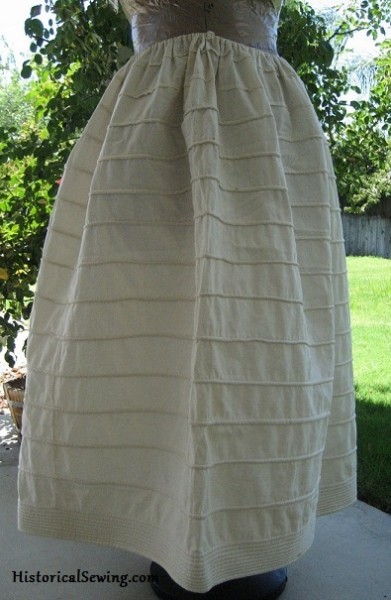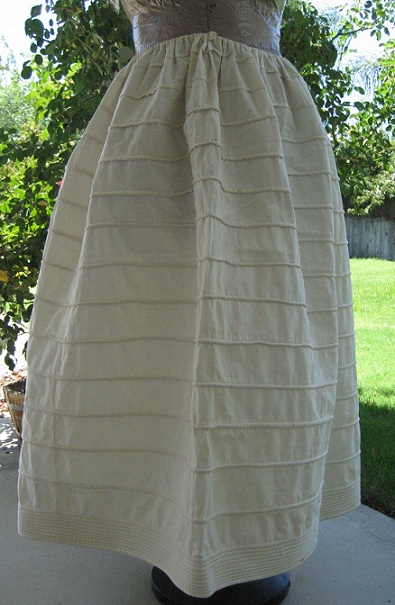
From the late 1820s through to the 1860s, there was a structural undergarment that was required in order to get the “proper” bell-shape to your skirt: the Corded Petticoat. It came into fashion right after the Regency era when the waist line was slowly dropping and before the American Civil War when hoop skirts were commonly used.
But what is a corded petticoat? Why do you need one? And how do they work?
Here are 5 questions and answers on corded petticoats to help you get a better feel for this undergarment.
1. What Did the Cording Do in the Petticoat That Made It a Requirement?
When reviewing current fashion periodicals with sketches of new styles, women noticed that fashion was taking the skirt and widening it at the hem. They began to make undergarments to create the new, fashionable silhouette.
(This presents the fun question: which came first the fashion or the undergarment. Both influenced each other to form styles around the other.)
Quilted petticoats had been around for centuries and were still worn by many. But now in the 1820s (and in previous times) horsehair was collected from horses’ tails and manes that was then woven into fabrics while on the loom. The coarseness of the hair created a stiff fabric. When made into petticoats, they were called crinoline petticoats (crin is French for horsehair and line for flax that is then made into linen fabric).
But looking for a more updated approach, fabric suppliers started weaving cords into fabric while on the loom. The cords gave the fabric a stiffness and added support to the top petticoats and skirt. Seamstresses would also take plain widths of fabric (usually linen or cotton) and sew in rows of cording to imitate what came out of the loom weaving.
So for the corded petticoat to be required, well, it was simply another undergarment to create the current, fashionable silhouette.
2. Did the Corded Petticoat Make the Skirt Stick Out That Much More Than a Regular Petticoat?
Even when wearing starched petticoats, the fabric falls softly around the legs. Petticoats naturally don’t stand away from the body. They support the top skirt. Ruffles on a petticoat will also enhance the width of the skirt.
Adding cords to fabric didn’t necessarily make it hang further out for an increased silhouette width, but they did kick out the skirt much more so than a plain petticoat. The types of fabrics you choose for your petticoats will affect the drape of them as well.
3. Did the Corded Petticoat Allow You to Wear Less Regular Petticoats?
Beginning with the 1820s, women most likely wore two petticoats. By the late ’20s and 30’s, if you study the widths of the skirt hems, they would need quite a few! In my studies of the 1840s and ’50s, I came across a book that mentioned up to 6 petticoats. This would include the corded petticoat or crinoline.
So possibly wearing a corded petticoat would allow you to get away with fewer regular petticoats. But as the years went by and fashion demanded wider skirts, more regular starched petticoats were thrown over the corded layer.
4. What Does Having Cords In The Petticoat Do?
“Three cords are stronger than one.” A single sheet of paper is hard-pressed to stand up alone when folded in half. But glue several sheets together like the thickness of card stock, then when folded in half, the paper stands up. When you sew cords (or padding or even fiber-fil) into fabric, it makes the fabric stiffer, allowing it stand on its own, thereby holding out your skirt away from your legs.
The main purpose of the corded petticoat was to hold the multiple layers of plain petticoats (necessary for a fashionable silhouette) further away from the legs making for easier movement.
5. Does a Corded Petticoat Allow the Plain Petticoats Over It to Stick Out Giving the Illusion of Wearing a Hoop?
Follow the fashion trends. Women of the 1830s and ’40s were making undergarments like the corded petticoat to flare their skirt hems as wide as possible. The previous fashion was the very slender, Greek styles. Before that, caned undergarments like the pocket hoops and panniers of the 18th Century were worn to support current fashion.
You can see the build-up of under layers throughout the Romantic Era that eventually demanded a support that would not collapse; hence the creation of the wired underskirt (cage crinoline) in 1856. Afterwards, the skirts widely expanded as they now had something to support the top skirts. The hoop freed up the many layers of petticoats, including the corded petticoat.
Yes, the corded petticoat allowed the skirt and top petticoats to “stick out more” than the previous fashions, but it was not a cage crinoline. The petticoat came from the natural progression of fashion from the narrow skirts of the Regency.
Learn more about corded petticoats and make your own with the pattern workbook.


What are the cords made of?
Primarily twisted cotton, but sisal, hemp and linen cording was used.
I actually like to “borrow” ideas from History, to make garments I can wear every day that are modest, of quality, and practical as well as demure. I wondered if a corded petticoat would help me with my walking skirts – I think I might only need that and one over-petticoat. Thank you for the Q & A here – I’m ready to give it a go!
After the aggravation of dealing with clingy petticoats with my work dress during hot summers of Civil War reenacting, I broke down and made myself a corded petticoat. What a dream! Gives just enough support to keep the other petticoats away from my legs and helps with air movement. Oh and of course it poofs things out just a bit to give a better sillouette. Definitely a must have and really not hard to make.